Arrangement of the ridge is the final stage of roof installation. The quality of the structure affects the aesthetic perception of the structure and the technical performance of the protective coating. The ridge of the roof can be made with your own hands on various roofing materials, but for each, the shape, size and type of profile are selected. The horizontal top line is formed by ridge soft elements, links made of galvanized steel, iron, wood.
Roof ridge device
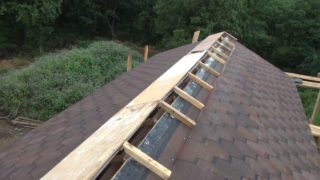
A simple version is a metal profile with a thickness of 0.7 mm with a single bend in the longitudinal direction at an angle of 90 °, which is changed depending on the steepness of the joining of the slopes. Special ridge links are made in various sections to ensure the correct geometry, ventilation, and water drainage.
The ridge performs the functions:
- protection of timber structures from rain, melt water in case of snow drift;
- prevention of breaking of roofing material under strong wind gusts;
- protection of the space under the roof from foliage, insects, dust;
- decorative design of the top of the house.
The material is chosen according to the type of roofing. For a high-quality arrangement of the upper line, it is necessary to perform the correct installation and mating of the rafters. Otherwise, the longitudinal element will bend, will not close the connecting gap, and cracks will appear on it over time.
Features of the ridge connection
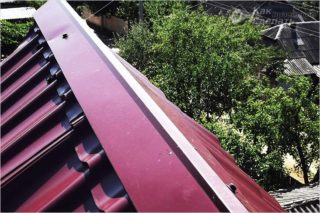
The general rules are followed when the roof ridge is mounted, despite the types of protective coating at home. Vapor barrier and waterproofing as part of the structure is made with breaks to release vapors and condensate from the under-roof area. Gaps in the membranes are not made if ventilation is provided using an automatic aerator or air vents.
Requirements for the installation of rafters and ridge links:
- the crate on the rafters is mounted with a gap at the top so that the gap between the pitched planes is at least 50 mm;
- to the top of the rafters, the sheathing bars are placed less often or they are changed with boards;
- the area of the ridge joint is insulated from moisture with a protective film along the rib, the width of the strip is at least 250 mm.
The nuances of the technology depend on the type of coating material used for the structure. To protect the ridge joint, factory products and elements of our own production are used.
Varieties of roof ridge
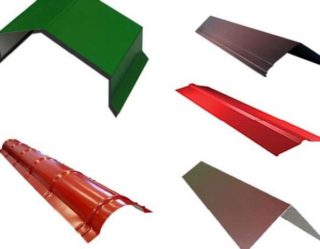
Ridge links are distinguished for hip, broken, gable structures, they repeat the shape of the material and are equal to the length of the docking rib. Convex roof corners are also classified as structures for which a roof ridge is installed to protect them.
Ridge elements depend on the style of the roof and are:
- straight;
- semicircular;
- curly;
- narrow.
More often, links are made of metal or galvanized, such combs are used for slate, polycarbonate. Manufacturers of roofing materials produce special shaped ribs for metal tiles, profiled sheets, corrugated board. For ceramic piece tiles, the skates are made of ceramics, complete with the main building material, they are mounted in the overall structure as a decorative continuation of the slope.Copper planes are provided with elements of the appropriate material and configuration. Thatched and reed floorings are finished with a ridge on the roof from the main type of frame.
Straight
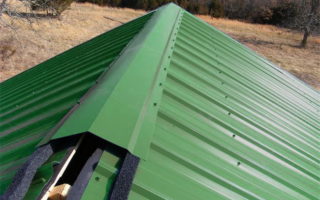
Flat elements are universal products that can be attached to almost all types of coverings and any configuration of slopes. The wing overhang on the sides is made from 200 to 300 mm, the size is determined depending on the slope, roof size and geometry. Such planks are easy to install, but their appearance on the covering of the house leaves much to be desired.
The rectangular profile is set using an auxiliary beam, which is fixed along the ridge rib along the line of joining the roof slopes. The seal is made with a suitable material, for example, foam rubber, rubber. Multilayer iron combs are used for composite shingles.
A straight profile is fastened using self-tapping screws with special caps; a plug is not placed at the end of the ridge. Hardware is used 10 - 20 mm longer than those used to fix the roofing sheets. Distinguish between straight simple and figured ridge for pitched and hip roofs.
Figured
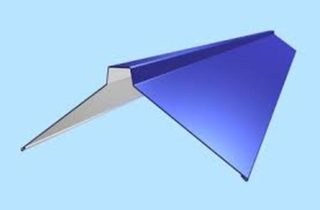
The width of a rectangular protrusion on the ridge of a flat profile is 20 - 40 mm, and it is performed by stepped bending. If the step size is made larger than 50 mm, the part may bend over time during service. For strength, metal corners are substituted in the form of additional fasteners.
The raised piece increases the clearance under the ridge and improves ventilation of the under-roof area. In summer, air exchange regulates the temperature of the attic space and prevents overheating of the roof. In winter, household heated air enters the space and prevents the formation of ice on the slopes.
The material is galvanized steel, profiled profile with polymerized spraying. For slate, strips of asbestos cement are put, but such material is used less and less.
Semicircular
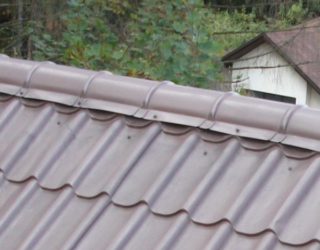
Radial or round elements of small and large radius from 70 to 125 ° are produced at factories, such elements are not produced independently. The use of one or another type is determined by the construction of the roof, the slope of the surfaces and the size of the wave. Such a ridge on the roof is often made of metal tiles with a polymer coating of various colors.
For production, the technology of stamping sheets with a thickness of 0.5 - 1.0 mm is used. Protruding ribs are placed along the length to give rigidity, while the joining of the two profiles is ensured by the mutual entry of the final and initial protrusions on the longitudinal element.
Manufacturers produce varieties of joints for a semicircular profile:
- T- and Y-shaped fittings (tee strips) for joining three or four roof ribs with a round ridge;
- special plugs of flat and conical shape to protect the holes on the end part of the ridge.
A seal is placed under the round ridge, which does not allow vapors and air to pass through, while making gaps. The ridge is fixed to the surface with self-tapping screws with washers made of elastic material. Sometimes the profile is additionally attached using a wooden beam at the junction of the slopes and a metal strip, which is mounted together with the ridge itself.
Functionally, the straight and semicircular options do not differ, so if the aesthetic side does not matter, they choose the first option to reduce the cost.
Narrow
The use of such an element is limited, since the wing outreach is only 150 - 200 mm, which is sometimes not enough to cover the joint of the roofing planes. They use a narrow variety for installation as a decorative addition on hipped-roof surfaces, coverings of picturesque gazebos, spiers and other structures.
For steep slopes, profiles are set bent at 90 °, and the gentle slopes are formed with ridge ridges with a bend angle of 135 °. Be sure to use seals so that precipitation does not fall into the attic or technical gap. For narrow profiles, universal, self-expanding and profile types of gaskets are used, especially when installing a hipped roof. Polyurethane foam is not used, because it tightly clogs the lumens and prevents air exchange.
Profile types
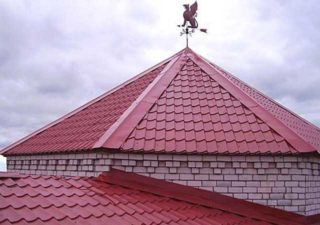
The type of ridge is chosen according to the material of the roof, while taking into account the design style of the house. On a roof made of type-setting natural tiles, a metal ridge on a galvanized roof looks inappropriate, but a semicircular type made of a painted iron profile to match the color of the flooring is quite suitable. For the minimalism style, pretentious figure skates with ribs resembling ceramic elements are not suitable.
For metal roofs (titanium-zinc, steel, aluminum, copper), ridge links are placed so high that they cover the wavy shapes of the covering sheets. Metal plugs and ready-made connecting elements are used, and a self-adhesive figured or wedge-shaped seal is mounted under the profile. The length of the ridge profile is always two meters, but the factories produce strips of different sizes according to the individual order of the client.
Ceramic roof tiles
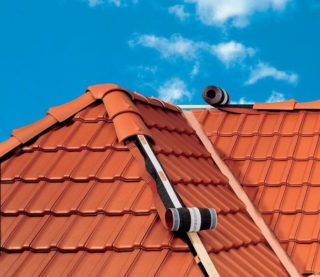
Manufacturers of natural tiles, take care of the top line in a uniform style and produce piece parts for the ridge roof. The individual links are laid one by one and aligned along the edge of the ridge. Right and left ridge tiles are provided, depending on the design of the slopes.
Preparation technology:
- install brackets on top of the girder or rails for attaching the ridge bar;
- a beam is mounted on the supports so that it does not overlap the ventilation gap, which is at least 1 cm between the surface of the slope and the ridge tile links;
- Firagol (protective tape against precipitation) is laid on the timber, its edges are glued to the upper edge of the tiles on the slopes.
Initially, the end caps are mounted, then the ceramic elements are installed in turn on the timber, the links are fixed with self-tapping screws of a special shape.
Slate
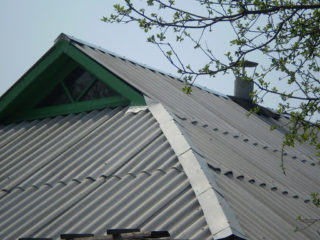
Slate slats are set by analogy with those used for metal tiles, but inexpensive galvanized steel is used, and slate nails are used for fixing. The elements are mounted so that the protruding edges of the next layer are in the direction of the wind prevailing in the construction region and do not rise with counter currents. The gaps between the strip and the troughs of the waves are sealed with a solution of cement and sand.
The roof ridge is a flat type that you can make yourself if you have a bending machine. Sheets are cut with metal scissors to size, clamped in the bed and bent to the desired angle. Expensive composite strips can also be mounted on slate.
Metal tile, corrugated board
These coatings are combined with a thin sheet metal profile painted with resistant polymer compounds. The metal tile has expressive shapes, therefore, semicircular ridge strips are used for it, which emphasize the relief. Similar ribs are placed on corrugated board and composite shingles.
Along the ridge of the roof, preliminary markings are made for installation. Stretch a nylon cord to maintain horizontal position. Installation is started from the end so that the edge of the finishing strip protrudes 3 cm beyond the timber. Docking is performed along the protruding stamping ribs. Fastening hardware is screwed into the crest of the wave with an electric drill.
Soft roll roof
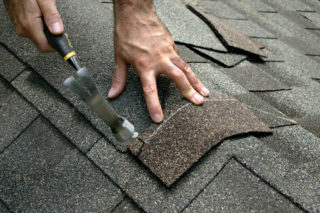
A ventilated ridge for a soft roof made of the same material is placed on bituminous tiles, roofing membranes and ondulin.Top elements are supplied by manufacturers at the same time as the main coating or workers cut out of the material themselves.
Auxiliary mastic layers reinforced with fiberglass are attached to the top of the slopes before installing the last layer of the soft roof.The first layer is placed perpendicular to the ridge, while the slope is overlapped by 30 cm.The second gasket is made in the transverse direction and overlap the previous layer by 15 cm.
The packaging film is removed from the bottom of the strips, the product is folded in half and mounted along the edge of the roof. For fastening, roofing nails are taken; when laying, the planks are overlapped. After gluing, the area of the ridge element is heated with a hairdryer or a special burner.
Stages of installing a roof ridge with your own hands
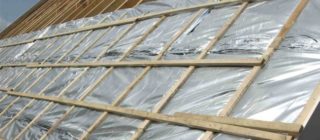
A prerequisite is a continuous covering at the top of the rafters from slats, OSB boards or planks laid flat. The bend angle of the ridge strip is adjusted to the level of joining of the slopes.
Work order:
- roll waterproofing is brought under the upper crate;
- mount the upper girder, on it - a longitudinal bar;
- the ridge is installed from the end, the seal is laid in parallel and pressed together with the strip;
- for connection on hip and hip roofs, factory overlays are used.
If an aeration element is used, it should be placed before the ridge is placed, with the self-adhesive side pieces attached to the base. In areas with strong winds, the ridge bar is not fixed to the coating material, but to the crate with long self-tapping screws.
Calculating the length of the ridge
For the calculation, measure the length of the protruding roof ridge, where you need to install the ridge elements. If there are several such lines, the number of stripes is calculated for each individual case. The length is divided by 2, 15 (standard size of the ridge strip + size of the overlap) and the number of planks is obtained.
To be sure of the number of profiles received, a schematic layout is made on paper, where the location of each element is indicated, taking into account the protrusion at the end. If the sketch is not completed, the initially obtained ridge length is multiplied by a factor of 1.05 to take into account the cutting.








